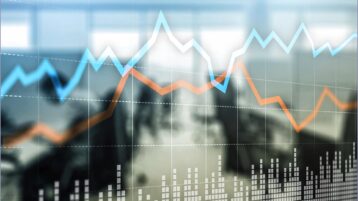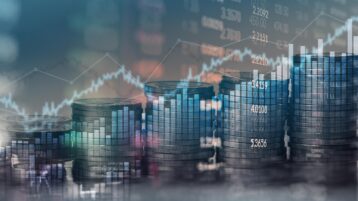The price of crude has been hovering around $80 per barrel, mainly on concerns about global demand and slowing economic growth. But Hussein Allidina, Head of Commodities at TD Asset Management, says that may change as China reopens and supply levels grow tighter.
Print Transcript
[AUDIO LOGO]
Commodities have had a good start to the year, along with other risk assets. But will that path higher continue with all this talk about slowing global growth? Joining us now with more, Hussein Allidina, Head of Commodities at TD Asset Management. Hussein, always great to have you back on the show.
HUSSEIN ALLIDINA: Thanks for having me.
GREG BONNELL: All right, so let's talk about it. In January-- after a pretty rough year last year, January looked pretty good across the risk assets. Commodity plays got a bid as well. So what are we going to say? Everything's going to be great for the rest of the year? Or are there things we need to worry about? I got a feeling there's things we need to worry about.
So I think the outlook is positive primarily because of the lack of investment that we've seen on the supply side. Clearly, you need to have demand growth. And I think part of the reason why commodities and other risky assets have performed well into 2023 is because expectations of improved demand and activity in China is lifting expectations of the forward balance and how tight things might be.
But of course, demand and the variability around demand and growth is a concern. The tightness on the supply side is still very prevalent. If we look at inventory balances, they have built. So if I look at oil balances, they're softer today than they were three months ago, primarily because we haven't had weather. It doesn't feel so much that way this morning. But we haven't had weather anywhere near normal. And that, I think, has resulted in some softness in the balance.
But when you take a sort of more medium term view, you look through year end, Chinese demand is probably up 600,000, 700,000, maybe 800,000 barrels a day this year, compared to last year where we contracted by 500,000 barrels a day. The SPR last year brought supply of about 500,000 barrels a day into the market. That likely doesn't happen again this year. And Russian production was very resilient last year. Most folks are anticipating a decline in Russian production. All those factors together, with robust or somewhat robust demand growth, points to a tighter balance.
A tighter balance in the near term. Longer term, there's been some interesting commentary, like a downright forecast. British Petroleum, one of the global energy majors, coming out and actually talking about where they see oil demand in the years ahead. I think you paid pretty close attention to that earlier in the week. What did you get from it?
Yeah, so I think for almost as long as I've been doing commodities-- and I won't date myself, but I had hair when I started doing commodities-- people have talked about demand growth peaking, demand growth peaking because of substitution to other forms of energy renewables, et cetera. BP, I think, is relatively optimistic on how quickly we're going to move away from conventional energy. But they, in their base case still see energy demand growing over the course of the next 10 years.
Again, and they're bearish relative to the Exons and some of the other players that forecast sort of longer term. If you're going to continue to have growing demand or steady demand, you have to address the supply side. And if you look at the CapEx, companies are not-- notwithstanding the fact that energy prices have increased, you're not seeing the CapEx that you need to be able to facilitate that supply to meet that demand.
Well, let's talk about that then. Because the trend seems to have been not toward investing in future production capacity and investing in the future of oil. It seems to be, let's reward shareholders with share buybacks, with special dividends, and not really invest in the business. Like what's going on? Can that be sustained longer term?
Well, there is this, I think, monumental shift on the CapEx side towards renewables. And going back to that BP report, they had a wonderful chart in there that shows the amount of investment needed per year. They break it down by region on the renewable front in order to be able to reach these sort of estimates that they have on the global energy balance. In all of the geographies around the world, the amount of investment needed on the renewable front is higher than we've ever done before.
So you need-- with the exception of China. China had a year that was elevated. But on average, the amount of investment that you need on the renewable side to meet those optimistic forecasts, I would say, are well above where we are right now. Even still, I think we have to remember that the growth in renewable, though good, is not meaningful enough to offset the magnitude of demand on the conventional front that we have today. We're going to consume 100 million barrels a day of oil this year.
To put that into context, 10 years ago, when we started talking about energy transition and substitution, we were consuming 90 million barrels a day. The global economy-- if you believe that GDP growth is something that is expected into the future, GDP is energy. And unfortunately, that energy today-- unfortunately, fortunately, depending on your perspective-- that energy today is still very oil, gas, and coal focused.
There would have been a time, too, where, as investors, people taking a look at the TSX and what the Kinney market had to offer, energy was a pretty big focus. Not that we still don't have some major names, but what's the situation there in terms of foreign investment dollars looking to Canada as an opportunity of inflows? What's the state of our industry here domestically?
Yeah, so I think if you look at the last 10 years, a lot of capital went into US shale production, because it was shorter cycle. The regulatory environment in the US was arguably more favorable than it was in Canada, than it is in Canada. I think that the productive resource in the US is not as meaningful as it was because we've gone through a lot of the sort of best acreage that we have.
Canada is pretty interesting. Particularly if we can figure out our pipeline constraints, our regulatory constraints, Canada has a relatively, I would say, clean resource. We have reasonable rule of law. And again, if you look at the opportunity set elsewhere, US shale is not doing what it has done historically. The economics there are not as favorable as we thought they were 10 years ago. I think Canada looks super interesting.
So we take that all together. We think about the year we had last year where energy was a clear winner in a very tough year for equities. But almost all of that was in the first half of the year. How does this year play out? If you had an investor just sort of looking at the energy space, whether it's Canadian stocks, whether it's global stocks, what kind of performance? Do we expect outsized or just something decent?
So I would say, on the commodity front, I anticipate that we will see further upside in oil prices. Oil is trading $80 a barrel. I think as the year progresses, and we have some more certainty on how weak demand is going to be and we can kind of get some conviction on what happens with Russian production, I think, almost regardless of how you cut it, the year probably ends tighter than where we started. And I think that is a positive for energy.
On energy equities, Greg, I think now that energy represents 5% ish of the S&P, folks have to look at it. And I think when folks look at it, which is something that they haven't had to do for the last 10 years-- once they start looking at the balance, I think they're going to come to very similar conclusions that people who are looking at the balance come to, in that, hey, we have a problem. We're still using a tremendous amount of oil to generate our GDP, but we've forgotten about the supply side, the investment side. Part of that is a symptom of the fact that we've been in a bear market for 10 years, 15 years, and there hasn't been an incentive to invest. Today the economics tell you that you should be investing. But there isn't necessarily the follow through, partially because of the concerns around energy transition and ESG.
[AUDIO LOGO]
[MUSIC PLAYING]
Commodities have had a good start to the year, along with other risk assets. But will that path higher continue with all this talk about slowing global growth? Joining us now with more, Hussein Allidina, Head of Commodities at TD Asset Management. Hussein, always great to have you back on the show.
HUSSEIN ALLIDINA: Thanks for having me.
GREG BONNELL: All right, so let's talk about it. In January-- after a pretty rough year last year, January looked pretty good across the risk assets. Commodity plays got a bid as well. So what are we going to say? Everything's going to be great for the rest of the year? Or are there things we need to worry about? I got a feeling there's things we need to worry about.
So I think the outlook is positive primarily because of the lack of investment that we've seen on the supply side. Clearly, you need to have demand growth. And I think part of the reason why commodities and other risky assets have performed well into 2023 is because expectations of improved demand and activity in China is lifting expectations of the forward balance and how tight things might be.
But of course, demand and the variability around demand and growth is a concern. The tightness on the supply side is still very prevalent. If we look at inventory balances, they have built. So if I look at oil balances, they're softer today than they were three months ago, primarily because we haven't had weather. It doesn't feel so much that way this morning. But we haven't had weather anywhere near normal. And that, I think, has resulted in some softness in the balance.
But when you take a sort of more medium term view, you look through year end, Chinese demand is probably up 600,000, 700,000, maybe 800,000 barrels a day this year, compared to last year where we contracted by 500,000 barrels a day. The SPR last year brought supply of about 500,000 barrels a day into the market. That likely doesn't happen again this year. And Russian production was very resilient last year. Most folks are anticipating a decline in Russian production. All those factors together, with robust or somewhat robust demand growth, points to a tighter balance.
A tighter balance in the near term. Longer term, there's been some interesting commentary, like a downright forecast. British Petroleum, one of the global energy majors, coming out and actually talking about where they see oil demand in the years ahead. I think you paid pretty close attention to that earlier in the week. What did you get from it?
Yeah, so I think for almost as long as I've been doing commodities-- and I won't date myself, but I had hair when I started doing commodities-- people have talked about demand growth peaking, demand growth peaking because of substitution to other forms of energy renewables, et cetera. BP, I think, is relatively optimistic on how quickly we're going to move away from conventional energy. But they, in their base case still see energy demand growing over the course of the next 10 years.
Again, and they're bearish relative to the Exons and some of the other players that forecast sort of longer term. If you're going to continue to have growing demand or steady demand, you have to address the supply side. And if you look at the CapEx, companies are not-- notwithstanding the fact that energy prices have increased, you're not seeing the CapEx that you need to be able to facilitate that supply to meet that demand.
Well, let's talk about that then. Because the trend seems to have been not toward investing in future production capacity and investing in the future of oil. It seems to be, let's reward shareholders with share buybacks, with special dividends, and not really invest in the business. Like what's going on? Can that be sustained longer term?
Well, there is this, I think, monumental shift on the CapEx side towards renewables. And going back to that BP report, they had a wonderful chart in there that shows the amount of investment needed per year. They break it down by region on the renewable front in order to be able to reach these sort of estimates that they have on the global energy balance. In all of the geographies around the world, the amount of investment needed on the renewable front is higher than we've ever done before.
So you need-- with the exception of China. China had a year that was elevated. But on average, the amount of investment that you need on the renewable side to meet those optimistic forecasts, I would say, are well above where we are right now. Even still, I think we have to remember that the growth in renewable, though good, is not meaningful enough to offset the magnitude of demand on the conventional front that we have today. We're going to consume 100 million barrels a day of oil this year.
To put that into context, 10 years ago, when we started talking about energy transition and substitution, we were consuming 90 million barrels a day. The global economy-- if you believe that GDP growth is something that is expected into the future, GDP is energy. And unfortunately, that energy today-- unfortunately, fortunately, depending on your perspective-- that energy today is still very oil, gas, and coal focused.
There would have been a time, too, where, as investors, people taking a look at the TSX and what the Kinney market had to offer, energy was a pretty big focus. Not that we still don't have some major names, but what's the situation there in terms of foreign investment dollars looking to Canada as an opportunity of inflows? What's the state of our industry here domestically?
Yeah, so I think if you look at the last 10 years, a lot of capital went into US shale production, because it was shorter cycle. The regulatory environment in the US was arguably more favorable than it was in Canada, than it is in Canada. I think that the productive resource in the US is not as meaningful as it was because we've gone through a lot of the sort of best acreage that we have.
Canada is pretty interesting. Particularly if we can figure out our pipeline constraints, our regulatory constraints, Canada has a relatively, I would say, clean resource. We have reasonable rule of law. And again, if you look at the opportunity set elsewhere, US shale is not doing what it has done historically. The economics there are not as favorable as we thought they were 10 years ago. I think Canada looks super interesting.
So we take that all together. We think about the year we had last year where energy was a clear winner in a very tough year for equities. But almost all of that was in the first half of the year. How does this year play out? If you had an investor just sort of looking at the energy space, whether it's Canadian stocks, whether it's global stocks, what kind of performance? Do we expect outsized or just something decent?
So I would say, on the commodity front, I anticipate that we will see further upside in oil prices. Oil is trading $80 a barrel. I think as the year progresses, and we have some more certainty on how weak demand is going to be and we can kind of get some conviction on what happens with Russian production, I think, almost regardless of how you cut it, the year probably ends tighter than where we started. And I think that is a positive for energy.
On energy equities, Greg, I think now that energy represents 5% ish of the S&P, folks have to look at it. And I think when folks look at it, which is something that they haven't had to do for the last 10 years-- once they start looking at the balance, I think they're going to come to very similar conclusions that people who are looking at the balance come to, in that, hey, we have a problem. We're still using a tremendous amount of oil to generate our GDP, but we've forgotten about the supply side, the investment side. Part of that is a symptom of the fact that we've been in a bear market for 10 years, 15 years, and there hasn't been an incentive to invest. Today the economics tell you that you should be investing. But there isn't necessarily the follow through, partially because of the concerns around energy transition and ESG.
[AUDIO LOGO]
[MUSIC PLAYING]



























